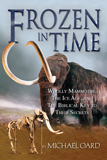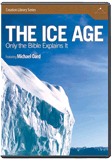Ice Age Feedback
Perspective
Secular scientists are finally showing by their research that they recognize a problem creationists have been pointing out for decades. A recent article in the journal Nature* seeks to resolve flaws in the prevailing Ice Age explanation, the astronomical theory. The astronomical theory does not adequately account for the supposed 100,000-year Milankovitch cycle of advancing and receding ice sheets and glaciers during a purported 2.6-million-year Ice Age that continues today. The researchers have developed a new computer climate model that they believe will help solve the problem with this deeply flawed theory. But does their explanation work?
The standard astronomical theory suggests that variations in the earth’s orbit and the tilt of its axis cause corresponding variations in the amount of the sun’s heat that reaches Earth. These peaks and valleys in solar heating supposedly control the cycles. However, the variation in solar heating alone is not great enough to explain the suggested 100,000-year period, so researchers suggest that some feedback mechanism must amplify the effect.
Creationists object to the astronomical theory primarily because the long passage of time conflicts with a biblical young-earth view. Any fluctuations in the ice coverage would have been short-lived during a single, brief Ice Age following the Tower of Babel. Creationists have published scientific objections to the astronomical theory, as well. The statistical evidence that past changes in the spread of ice correlate with variations in the earth’s orbit is highly questionable—and the 100,000-year period they identified has the weakest such correlation.** In addition, until recently, no details had been offered for any possible feedback mechanism.
The report’s authors, Abe-Ouchi and his coworkers, recognize the validity of such criticisms (although they probably would not admit creationists were involved in pointing them out). They considered a number of feedback mechanisms in their climate model and settled on a “delayed rebound of bedrock” as the primary explanation for the 100,000-year cycles. The rebound of bedrock refers to the sinking and rising of rock in the earth’s crust, as heavy loads of ice are added and removed.
Scientific research is not static. Abe-Ouchi and his colleagues have attempted to address problems with their theory and continue to refine their model. This means that creationists must continue to keep up-to-date in the battle for truth. As evolutionists refine their theories, creationists must make sure they respond with quality scientific experiments and model-building, too. The integrity of our research methods bolsters our message, as we ultimately appeal to the truth of God’s Word.
*Abe-Ouchi, A, F. Saito, K. Kawamura, M. E. Raymo, J. Okuno, K. Takahashi, and H. Blatter, “Isolation-driven 100,000-year Glacial Cycles and Hysteresis of Ice-sheet Volume,” Nature, Letter 500 (August 2013): 190–194.
**Vardiman, L., “Rapid Changes in Oxygen Isotope Content of Ice Cores Caused by Fractionation and Trajectory Dispersion near the Edge of an Ice Shelf,” Creation Ex Nihilo Technical Journal 11 (1997): 52–60.
Answers Magazine
January – March 2014
Placed safely in our solar system’s “goldilocks zone” and engineered with the perfect balance of atmosphere, chemicals, and water, our earth was miraculously formed to be inhabited (Isaiah 45:18). This issue examines the earth’s unique suitability for life. We’ll also investigate what seminaries are actually teaching our pastors, the possibility that viruses could be beneficial, and more.
Browse Issue SubscribeRecommended Resources

Answers in Genesis is an apologetics ministry, dedicated to helping Christians defend their faith and proclaim the good news of Jesus Christ.
- Customer Service 800.778.3390
- © 2024 Answers in Genesis






